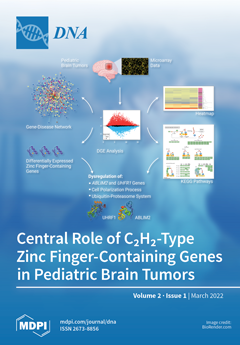Open AccessArticle
Central Role of C2H2-Type Zinc Finger-Containing Genes in Pediatric Brain Tumors
by
Dimitrios S. Kanakoglou, Andromachi Pampalou, Lina S. Malakou, Eleftheria Lakiotaki, Theodoros Loupis, Dimitrios M. Vrachnos, Panayiotis D. Glekas, Alexia Klonou, Angeliki-Ioanna Giannopoulou, Madison Carpenter, Penelope Korkolopoulou and Christina Piperi
Viewed by 4818
Abstract
Zinc fingers consist of one of the most abundant motifs in transcription factors and DNA-binding proteins. Recent studies provide evidence on the pathological implication of zinc finger proteins in various neurodevelopmental disorders and malignancies but their role in pediatric brain tumors is largely
[...] Read more.
Zinc fingers consist of one of the most abundant motifs in transcription factors and DNA-binding proteins. Recent studies provide evidence on the pathological implication of zinc finger proteins in various neurodevelopmental disorders and malignancies but their role in pediatric brain tumors is largely unexplored. To this end, we investigated the differential expression of zinc finger-containing genes along with relevant biological processes and pathways among four main brain tumor categories (pilocytic astrocytomas, ependymomas, medulloblastomas and glioblastomas). By employing an extended bioinformatic toolset, we performed a preliminary in silico study in order to identify the expression of zinc finger-containing genes and associated functions in pediatric brain tumors. Our data analysis reveals the prominent role of C
2H
2-type zinc finger-containing genes in the molecular mechanisms underlying pediatric brain tumors followed by the Ring and PHD finger types. Significant dysregulation of
ABLIM2 and
UHFR1 genes was detected in all tumor types drawing attention to the dysregulation of cell polarization process and Ubiquitin-Proteasome System (UPS) in the pathogenesis of pediatric brain tumors. Moreover, significant gene clustering was observed in multiple locations with two highly visible clusters revealing a contrast in gene regulation between medulloblastomas and the other three brain tumor types, indicating a promising area of future research.
Full article
►▼
Show Figures



